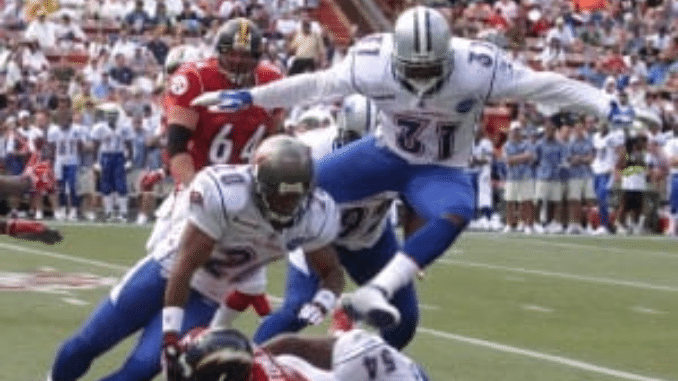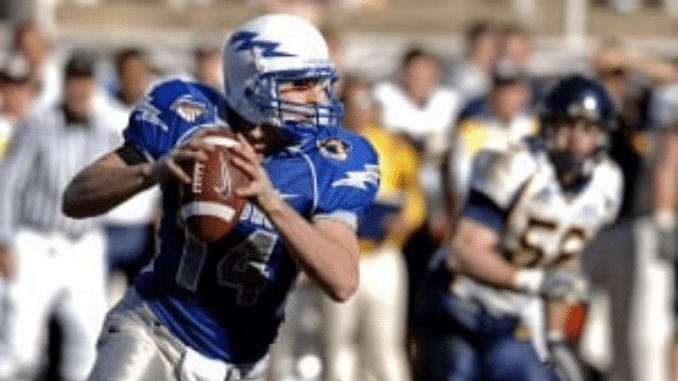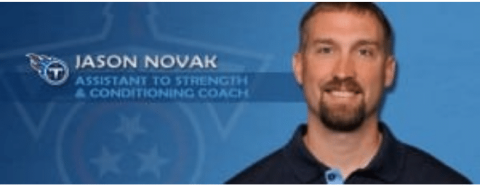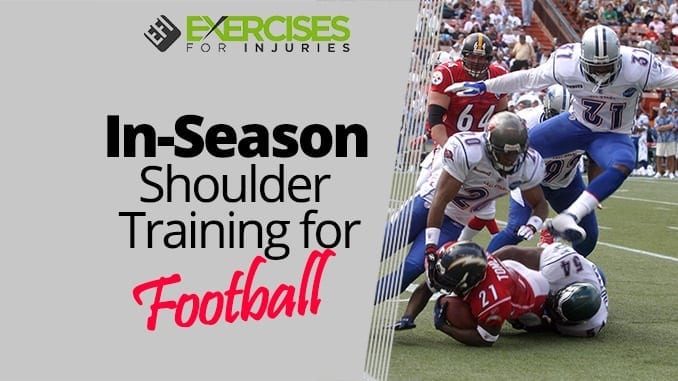
With the Super Bowl, I thought about shoulder training and football. I asked someone who works with football players and shoulders every day.
I asked Jason Novak to share what he does working with in-season football players regarding shoulder training and health.
Enjoy!
Take it away, Jason:
Training the shoulder is one of the stricter programming challenges we face with our players during the season. Due to the nature of the sport and position-specific demands, our primary objective in-season is to keep the training simple and be very consistent in doing it.
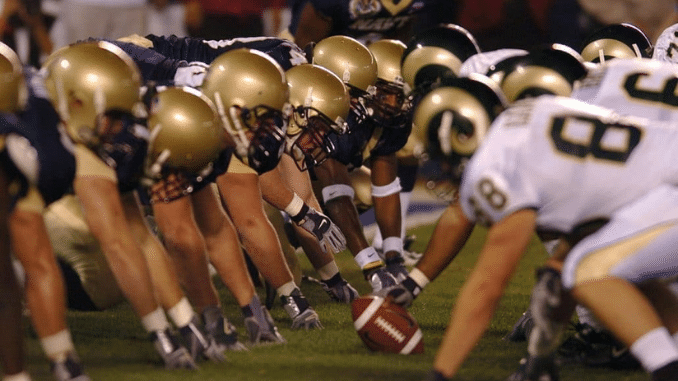
We train four times weekly, each session lasting 30-45 minutes as a team. Each day begins with a functional warm-up and mobility exercises that last 8-12 minutes and generally ramp up in intensity as it progresses and complements the workout.
We utilize many tools during the warm-up routines, including jump ropes, suspension training devices, kettlebells, medicine balls, dumbbells, and bodyweight exercises, to add variety to the ways and keep our athletes mentally in tune with preparing for the training.
Our In-Season training has three phases: training camp, early/mid-season, and late-season/playoffs.
Training Camp (Phase #1)
Essentially, this phase is an extension of the off-season program.
We train heavily during training camp due to the higher numbers on the roster and fewer reps our veteran players have to take in practice and games. We try to balance out every “push” we do with a “pull,” whether chest pressing or overhead pressing.
For “pulls,” we use suspension trainer row variations, half-kneeling cable row variations, heavy, low rep single-arm dumbbell rows, and pull-ups with various grips. During this phase, our primary strength training for the shoulder comes from the Clean + Push Press.
We use bars, dumbbells, and kettlebells for this activity, depending on the athlete and any restrictions they may have.
Typically we follow this with one of three dumbbell complexes (reps will vary):
| 1 | 2 | 3 |
| a. Front raise | a. upright row | a. Turkish Getups |
| b. Side raise | b. hang snatch | -Kettlebell, Dumbell |
| c. Bent raise | c. squat + press | -whole / segmental |
| d. Alt. curl + press | d. bent over row |
Example Training Day:
- Clean + Press: 57.5-62.5% x 4 reps, 70-75% x 3 reps, 77.5-85% x 2 reps / 3-6 sets **
**superset box jumps with top sets - Pullups : Skill (WR, DB, RB) group x 30reps, Middle group (DE, TE, LB, FB) x 25 reps, Linemen (OL/DT) x 15 reps
- Turkish Getup x 4 on the left and right side
Early/Mid-Season (Phase #2)
Once the regular season begins, things change rather quickly and drastically with our training.
Due to the nature of this sport and roster size limitations, our athletes play with quite a few injuries and tremendous pain (especially in the shoulders). A point of emphasis now becomes completing the training without causing further irritation to an existing injury or pain and hopefully aiding in the healing process.
So, that leads you down a path of creativity to find a way for the athlete to get the work they need to be done.
This is always one of our biggest challenges as strength and conditioning coaches.
Olympic Season
We continue to do Olympic lifts throughout the entire season, keeping the percentages lower and emphasizing the technique and speed of the bar.
At this time, we begin to modify the exercises by using kettlebells and dumbbells for our Cleans, Clean + Presses, and Snatches. As the season wears on, many of our athletes prefer to use kettlebells instead of traditional Olympic bars for certain lifts because they tend to be easier on the shoulders, especially their wrists.
As for direct shoulder work like overhead pressing, we primarily stick to using dumbbells and kettlebells. We do very little overhead work with straight bars unless it is a part of an Olympic lift like Clean+ Press or Snatch.
Our philosophy is to keep these exercises unilateral, so we typically only use one dumbbell or kettlebell at a time. This keeps the total weight a bit lighter and allows them to concentrate on form and technique.
Additionally, we perform most of our pushup variations and abdominal training using suspension devices such as TRX or rings with our feet or hands elevated to require more postural and shoulder stability.
We use two exercises quite a bit during this time of year: the kettlebell windmill and the “half-version” of the Turkish Get Up, which is made up of just the “ground” portion of the lift and not coming to a full standing upright position. We introduce different implements during these exercises, such as dumbbells and bars instead of kettlebells. This builds excellent stability in the shoulder and requires tremendous core strength to complete.
Mid-Season – Late/Post-Season (Phase #3)
Our athletes are all dealing with some pain/injury during this time of year, and their bodies have absorbed more punishment than seems possible.
Our goal is to help them maintain as much strength as possible yet allow their bodies time to heal throughout the entire week.
We place a great deal of emphasis on incorporating chains and bands during the last half of the season. This accommodating resistance works excellently for our athletes as it is easier on their joints because the weight is lightest at the weakest and heaviest at the most vital angles.
The volume tends to be very low, but the relative intensity on the bar can be pretty high when accounting for the added resistance of the chains or bands. The added volume has to be avoided at this point in the season.
We still incorporate mostly dumbbell complexes for extra shoulder work. And continue with appropriate variations of the Windmill and Turkish Getup.
Consistent training is crucial. We tend not to eliminate anything from our training routine as the season progresses. We try to emphasize that rather than eliminating a movement. Once you stop using a movement pattern, you lose it. Please find a way to modify it to remain relevant and appropriate for the athlete.
Who Am I?
My name is Jason Novak. I am the Assistant Strength and Conditioning Coach for the Tennessee Titans. This is my eighth year in the NFL, all with the Titans. Previously, I was the Director of Strength and Conditioning at Yale University and the Head Strength Coach at Alabama State University. I have a Master’s Degree in Sport Management from Baylor University and a Bachelor of Science in Kinesiology from Stephen F. Austin State University.
Big thanks, Jason.
Great info. Thank you for sharing.
Jason is a Muscle Imbalances Revealed – Upper Body Edition customer. He emailed me, and I saw what he did from the signature in his email. After seeing that, I asked if he would share some info.
That is it for today.
Take care.
Rick Kaselj, MS
For products related to shoulder injuries and training, check out:
- Muscle Imbalances Revealed – Upper Body Edition
- Effective Rotator Cuff Exercises
- Scapular Stabilization Exercises
Here are some other shoulder injury and training articles that may interest you:

